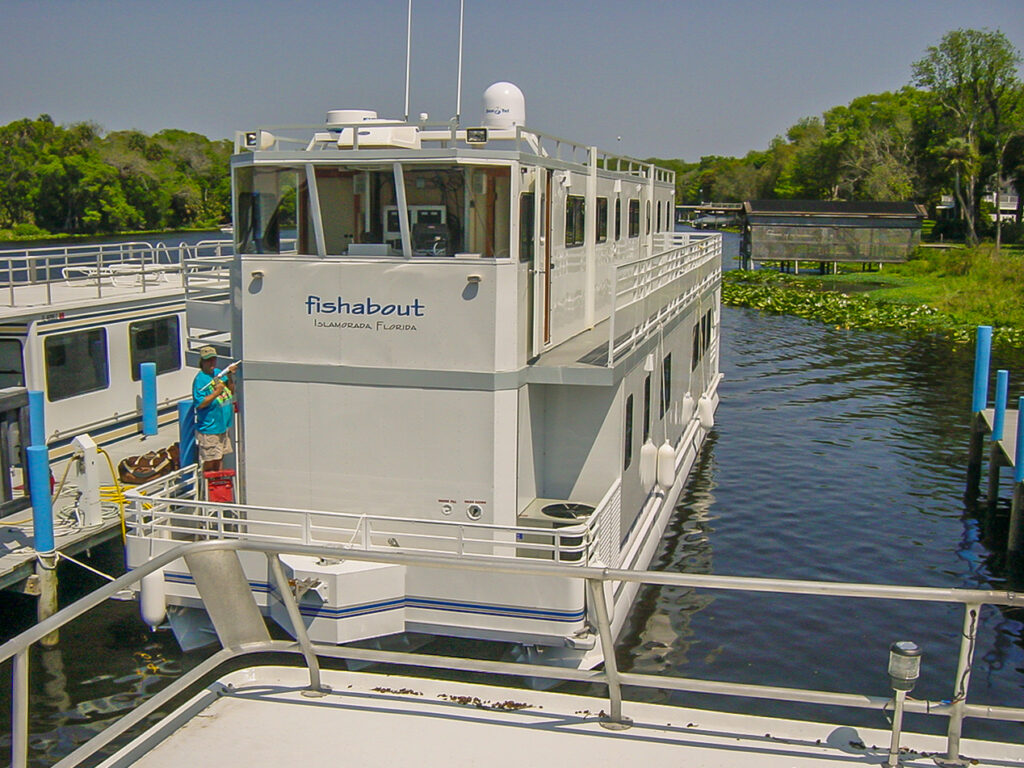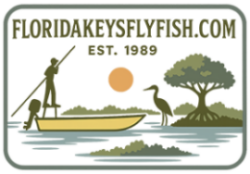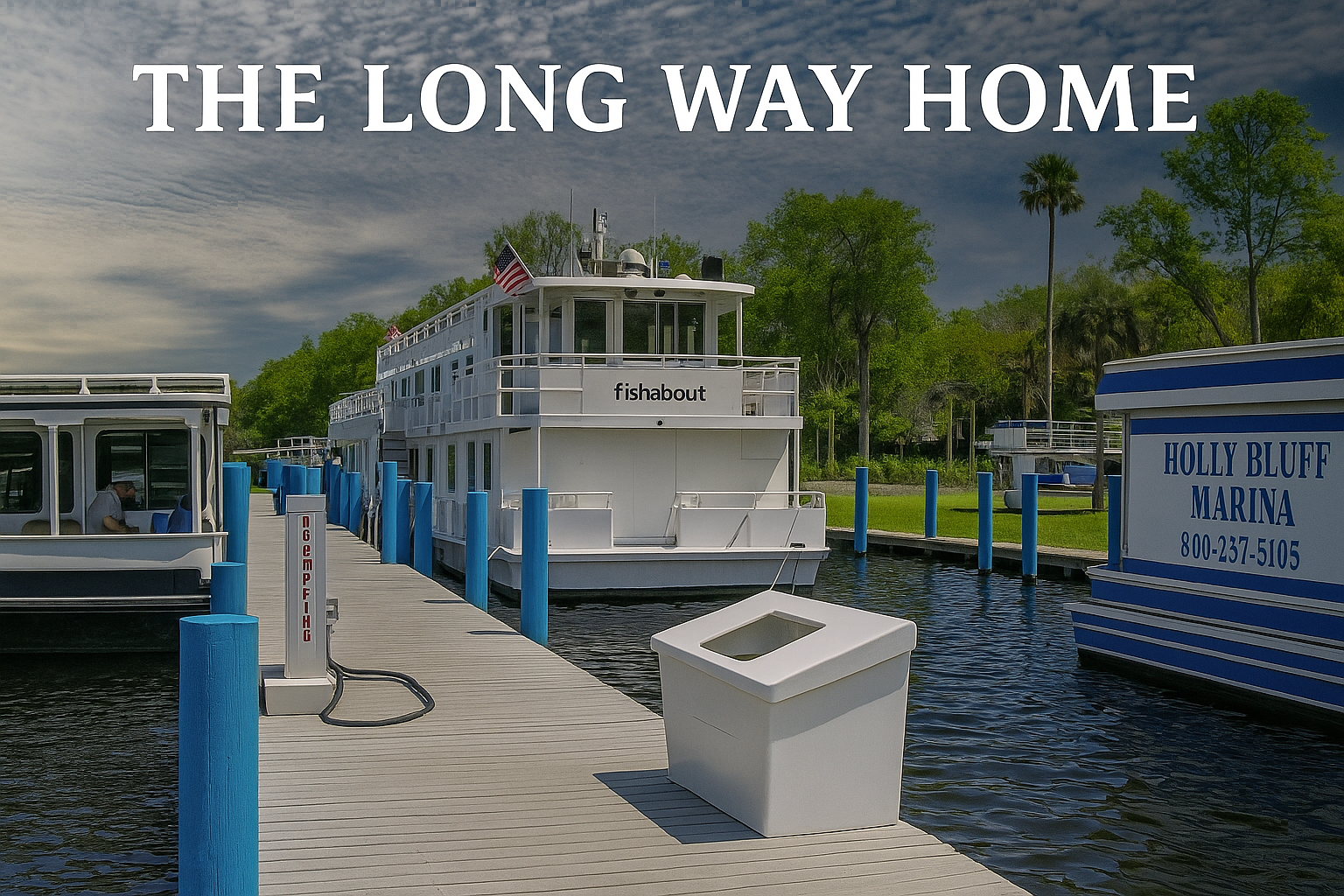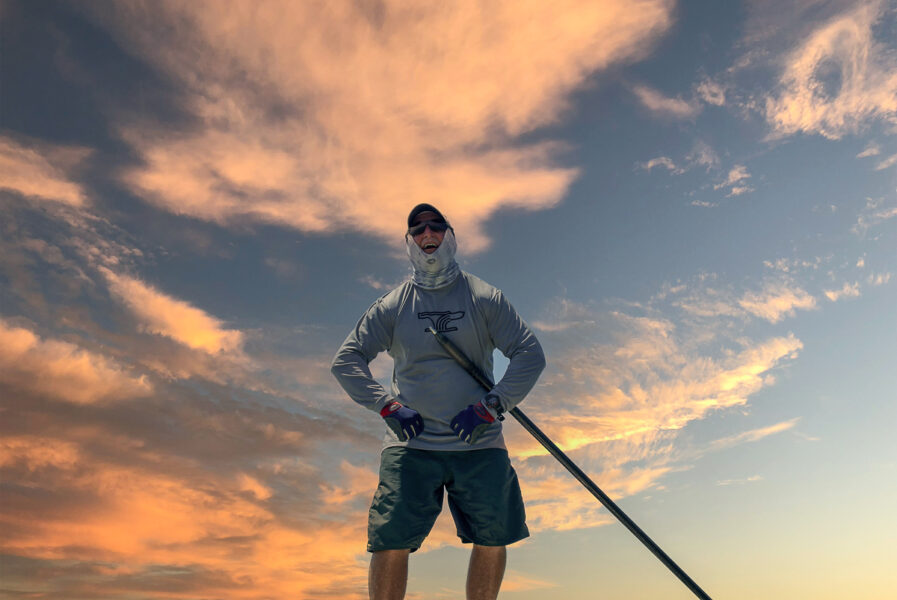The Idea That Floated
This isn’t exactly where the story starts… nor where it ends.
Mike Burgreen and I had been running outfitted camping trips in the Everglades under the Fishabout banner for a few years. Two or three days at a time, deep in the Glades, fishing by day and camping by night. Mike handled the outfitting, and we ran skiffs into places that didn’t appear on most charts. And Mike cooked gourmet meals that kept us all going. We got soaking wet, froze during cold fronts, got eaten alive by no-see-ums and mosquitoes, raided by raccoons, and came back grinning every time.
It worked because we were doing something different. And our clients, anglers who weren’t interested in crowds or cushy lodges, loved it. But there was one problem. Comfort had its limits, and logistics were brutal. No running water. No A/C. Long rides in and out. Every piece of gear had to be hauled, set up, and broken down every time.
That’s when the mothership idea started making the rounds around the campfire. A vessel that could live out there with us. Air conditioning, showers, real beds, and a galley. Not a yacht, but more like a floating lodge with good food. Something practical, rugged, and built to our specs, and that we could afford to build.
It didn’t take long to move from idea to action. We formed a company, Outback Ventures, brought in a couple of investors, and found a builder in Central Florida who was willing to work with us. Trident wasn’t a typical yacht yard, they built industrial vessels: riverboats, ferries, dinner cruisers. Perfect. We gave them our specs and started making the long drive north from Islamorada to Tavares every week to oversee construction.
We were both big sports fans, and as much as we loved being off the grid, we hated missing the games. That probably had something to do with why we made sure Fishabout had multiple TVs and a satellite tracking system. Out in the Glades while camping, we rigged up an old 3-watt car phone to an antenna on a push pole just to get a signal. We needed a way to stay connected, especially with my wife eight months pregnant at the time.
Eighteen months later, the boat was ready, at least on paper. She was called Fishabout. Seventy feet of steel and aluminum, built from scratch, designed to host anglers, guides, and crew in remote water for days at a time.
The Launch at Holly Bluff
 Fishabout was shipped from Trident’s yard, 30 miles away in Tavares, to Holly Bluff Marina on the St. Johns River. She arrived in two sections, hull and superstructure, on wide-load flatbeds with two escort vehicles. The plan was to assemble her at the marina, launch her, and begin the delivery trip south. I was there for the better part of the week, helping oversee the final stages of the build and preparation.
Fishabout was shipped from Trident’s yard, 30 miles away in Tavares, to Holly Bluff Marina on the St. Johns River. She arrived in two sections, hull and superstructure, on wide-load flatbeds with two escort vehicles. The plan was to assemble her at the marina, launch her, and begin the delivery trip south. I was there for the better part of the week, helping oversee the final stages of the build and preparation.
The work wasn’t smooth. Timelines slipped. Several systems still needed adjustment or installation, and we dealt with a rotating cast of subcontractors, some more dependable than others. One of the more memorable ones was Janice, a tough-as-nails carpenter with a mullet, a loud voice, and a vocabulary that could make a sailor blush. She worked hard, drank harder, and didn’t take orders from anyone, but most of the time, she was damn good at what she did. You just had to stay out of her way and let her do her thing.
Her counterpart on the crew was Larry, a soft-spoken guy with a quiet fondness for whatever was in his cup and just enough know-how to stay useful. He was a drifter who eventually found his way onto an old sailboat and took residence there, a perfect fit. Larry didn’t say much, didn’t get rattled, and mostly kept to himself. Like Janice, he was a Trident employee. The two of them were an odd pair, but for a while, it worked, until it didn’t.
Mike and I spent long hours tracking progress, troubleshooting issues, and working directly with the crew from Trident to get the vessel operational. We were living on the boat while all this was happening, and getting to know every corner of Fishabout, whether we wanted to or not.
Meals usually came from just up the road at the Shady Oaks. The place had been around since the 1950s, started as a fish camp, and still had the kind of worn-in charm you only get from decades on the river. A fried catfish basket with hushpuppies and coleslaw, and an iced tea from Shady Oaks weren’t fancy, but they hit the spot. And after a few days, we were on a first-name basis with the folks behind the counter. We’d eat on the porch, watch boats slide by on the St. Johns, and almost forget how much work still needed to be done back at the dock.
The systems onboard were coming together, but not without problems. Both generators were acting up. The water maker was still giving us trouble. Electrical work was ongoing. Some issues were resolved, others flagged to be handled underway.
I had planned to join Mike for the entire trip, but what was supposed to be a one-week stay turned into two, and I had to get back to the Keys to work. Fishabout was close to launch, but not everything had been tested under load, and the crew was still getting familiar with the boat. Mike stayed behind to carry the load through the final punch list and prep her for the maiden run.
I wasn’t aboard when they finally pulled away from Holly Bluff. From that point on, everything I know about the trip came from Mike, and the way he told it, things started to unravel not long after they cleared Jacksonville.
The Run Up the St. Johns
Fishabout’s clearance was about twenty-five feet, which had already made for a few close calls under bridges upriver. But that was just a warm-up for what lay ahead. Once they hit the Intracoastal, the real bridge gauntlet would begin.
The first leg of the journey wasn’t south, but north. The St. Johns River flows from south to north, and to reach the Intracoastal Waterway and begin the long trip down the coast to the Keys, you first have to run upriver to Jacksonville. There’s no other way to get there by water.
It was mid-March, which in North Florida means cold fronts, often strong, always windy.
The route from Holly Bluff to Jacksonville covers about 120 miles, past Palatka, Green Cove Springs, then Jacksonville. And under what felt like an endless series of bridges, fixed, swing, bascule, you name it, that marked the last stretch of the river before you reached saltwater. For a brand-new vessel with systems still being tested and a crew still learning the ropes. It was a long and slow introduction.
Mike was at the helm for the entire run, with a skeleton crew from Trident onboard. Trident had volunteered Janice and Larry to crew the trip, maybe as a favor, or just to get them off the yard for a while. The plan was to reach Jacksonville in a couple of days, weather allowing, then make the hard right onto the ICW and begin the real push south. But nothing about this trip was going to stick to plan.
The first front hit just south of Jacksonville, while still on the St. Johns. Temperatures dropped fast, and the wind funneled right up the river. What had been a calm, steady run turned into a noisy, teeth-rattling crawl. And one of the crew started getting seasick, which is impressive on a river.
Mike kept her moving, trying to keep the ride manageable. There was no real failure, just a constant low-level mess of things that weren’t quite right. And with every mile upriver, the idea of ‘shakedown cruise’ became less of a formality and more of a grim prophecy.
Southbound
After leaving Jacksonville, the real journey began. The Intracoastal Waterway would carry Fishabout south for hundreds of miles, but not without a fight. The route may be relatively sheltered, but it’s a stop-start grind, especially for a boat with a twenty-five-foot clearance.
From the Bridge of Lions in St. Augustine to the 17th Street Causeway in Fort Lauderdale, the list of bridges seemed endless. And with our clearance, they weren’t tall enough to require openings, but Fishabout was tall and wide enough to make every one of them a nail-biter.
Most passed without issue, but there were plenty of stressful moments. A couple of bridges looked like they’d peel the radar dome right off. Mike stayed sharp, lining up each approach with the patience of a surgeon. Larry usually stood on the bow as a spotter, sometimes helpful, sometimes not. Janice would occasionally holler suggestions from the stern, most of them unprintable.
The bridges were only part of the problem. The ICW is narrow in places, shallow in others, and often clogged with weekend warriors and pleasure boaters. Navigation took constant attention.
Fuel stops were slow. Marinas were tight. Overnight anchorage, when there was one, was a negotiation. Mike handled it all. And every night ended with the same question. Janice and Larry would ask, “How many miles did we do today? How much further do we have to go?” Some days it was eighty. Others, with a fuel stop, barely forty. But the slow progress was part of the price.
Further ‘South’
The real trouble started after a necessary fueling up and picking up some provisions at Melbourne Harbor Marina, during a second cold front with winds gusting to 35 knots. Not exactly ideal conditions for a graceful departure.
Mike was forward, upstairs in the wheelhouse. Janice was on the stern, and Larry was handling the bow lines. Pretty standard stuff. Unbeknownst to Mike, Janice missed the stern line the dockmaster had thrown to her. It dropped, twisted, and wrapped itself into both propellers like it had meant to be there.
With no steerage and no power, Fishabout was adrift in the harbor. And of course, they didn’t have walkie-talkies (yet) handy to pass the word. Now moving sideways in 35 knots of wind, the boat had all the grace of a barn door in a wind tunnel.
The closest object? A gorgeous 120-foot Burger yacht. Just beyond that, a neat row of sailboats, all moored peacefully, unaware that seventy tons of surprise was headed their way.
Larry was shouting from the bow, Janice was scrambling aft, trying not to spill her beer, and Mike, alone in the wheelhouse, was calmly doing what he could. No panic, just action. He sized up the wind, the drift, and the options. The throttles were unresponsive, but Mike wasn’t. He stayed focused, knowing full well what was at stake. Everyone onboard had learned the same lesson at once: big boats don’t forgive small mistakes.
Fishabout had already made contact. After bumping the Burger, Mike made the quick decision to leap aboard the yacht and lash a line to it, a gutsy move that kept Fishabout from pinballing into the surrounding fleet. It wasn’t pretty, but it was bold and extremely dangerous, and it worked.
Fortunately, the crash bags had been deployed on that side. No real disaster, at least nothing catastrophic. But the extent of the damage, still to be determined by the insurance companies. On a superyacht, “minimal damage” can mean anything under fifty grand. This turned out to be the first insurance claim, but not the last.
The Final Leg
The last stretch from Fort Lauderdale to Islamorada should’ve been the easiest part of the whole run. After everything that had happened, bridge dodging, engine issues, prop fouling, and that little fender-bender with a Burger yacht. This final push felt like the home stretch.
But nothing about Fishabout’s maiden voyage had gone by the book, and this wasn’t about to change.
The biggest problem turned out to be that Janice and Larry were intoxicated most of the time. What started as a few drinks at the dock had continued well into the trip. Their reliability, never stellar to begin with, deteriorated by the mile, leaving Mike to shoulder nearly everything himself. On a good day, they were dead weight. On a bad one, they were a liability.
At one point, they even threatened to jump ship if Mike didn’t make a beer run. So, like any rational captain in charge of a steel vessel the size of a double-wide barreling toward the Keys, he pulled over and bought several cases of beer. It was that or finish the trip solo, something the insurance company probably wouldn’t have found as amusing as the rest of us.
Numerous calls to Trident for backup or at least guidance were met with cLarryets, or worse, cheerful confusion. You got the sense they were just glad Janice and Larry were someone else’s problem now.
Arrival at Founders Park
The final leg followed a more predictable course: Biscayne Bay, through Card and Barnes Sound, then under the bridge at Jewfish Creek, Blackwater, and Buttonwood Sound, and down the Intracoastal to Founders Park. The wind had eased up, the water relatively calm, and Mike kept Fishabout on track, steady, if not entirely stress-free. And after a few more long days and short tempers, Fishabout finally went through the Cowpens and into Yacht Harbor at Founders Park.
I met them at Founders, and Mike docked her with the kind of quiet satisfaction that only comes after a month of problem-solving and chaos management. He tied off the last line, shut down the systems, and stepped onto the dock like a man walking out of the wilderness.
The crew disembarked with little fanfare, with Larry sloshing slightly, Janice muttering something about needing a break from men and boats. Mike didn’t say much, but those who knew him could tell. Seeing them walk away was one of the highlights of the trip.
Fishabout had made it. Banged up, behind schedule, and battle-tested, but floating, and finally home. But now, the adventure began.
Staying Afloat
The voyage to Islamorada was never meant to be easy, though no one expected it to cost the insurance company $25,000. It was a proving ground, part test run, part endurance contest, and part fire drill. But in the end, Fishabout delivered on the promise that launched her. She became the floating base camp we’d envisioned, bringing anglers into the heart of the Glades, the Content Keys, and the Marquesas. She gave guides and clients a place to rest, reset, and write new chapters in the story of fishing adventures.
For four and a half years, she served as the mothership to dozens of remote trips. Some ran like clockwork. Others… didn’t. But every trip carried the spirit of the original idea, to take people farther, let them stay longer, and do it with professionalism and with enough comfort to keep it enjoyable.
Eventually, bureaucracy caught up with us. Permitting roadblocks and red tape put an end to the program, not because it didn’t work, but because too many people in too many offices couldn’t figure out what to do with something that had never existed before.
Still, Fishabout had already done her job. She proved the concept. She gave us memories, scars, and stories that still get passed around whenever guides and anglers sit around long enough to swap tales. And she gave Mike and me something else, a hard-earned respect for big ideas, big boats, and all the little things you don’t see coming.
She eventually found a new purpose as a floating office at the Lorelei Cabana Bar and Marina in Islamorada. Not a bad retirement.
She may still be floating. But to us, she’ll always be anchored in that stretch of time when a crazy idea became real and survived just long enough to become legend.


